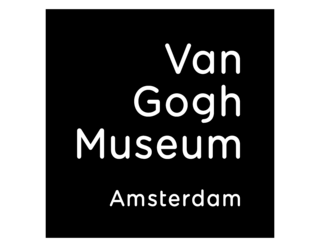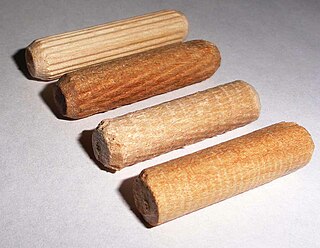This article needs additional citations for verification .(January 2023) |

A Rietveld joint, also called a Cartesian node in furniture-making, is an overlapping joint of three battens in the three orthogonal directions.
This article needs additional citations for verification .(January 2023) |

A Rietveld joint, also called a Cartesian node in furniture-making, is an overlapping joint of three battens in the three orthogonal directions.
A Rietveld joint is an overlapping joint of three battens in the three orthogonal directions. It was a prominent feature in the Red and Blue Chair that was designed by Gerrit Rietveld. In Gerrit Rietveld's furniture, many of these joints were doweled, meaning that the adjoining faces were connected with glued wooden pins. The first two connections were made by boring a hole about 1 mm deeper than the dowel length, but the third connection was made with a longer dowel, boring through a batten, leaving a circular mark that had to be painted over. [1]
Rietveld joints are inextricably linked with the early 20th century Dutch artistic movement called De Stijl (of which Gerrit Rietveld was a member), a movement whose aims included ultimate simplicity and abstraction. This led to the movement's three-dimensional works having vertical and horizontal lines that are positioned in layers or planes that do not intersect, thereby allowing each element to exist independently and unobstructed by other elements and giving a piece a visually raw and simplified look.

Gerrit Rietveld was a Dutch furniture designer and architect.

Joinery is a part of woodworking that involves joining pieces of wood, engineered lumber, or synthetic substitutes, to produce more complex items. Some woodworking joints employ mechanical fasteners, bindings, or adhesives, while others use only wood elements.

The Van Gogh Museum is a Dutch art museum dedicated to the works of Vincent van Gogh and his contemporaries in the Museum Square in Amsterdam South, close to the Stedelijk Museum, the Rijksmuseum, and the Concertgebouw. The museum opened on 2 June 1973, and its buildings were designed by Gerrit Rietveld and Kisho Kurokawa.

De Stijl, also known as Neoplasticism, was a Dutch art movement founded in 1917 in Leiden. De Stijl consisted of artists and architects. In a more narrow sense, the term De Stijl is used to refer to a body of work from 1917 to 1931 founded in the Netherlands. Proponents of De Stijl advocated pure abstraction and universality by a reduction to the essentials of form and colour; they simplified visual compositions to vertical and horizontal, using only black, white and primary colors.

A fastener or fastening is a hardware device that mechanically joins or affixes two or more objects together. In general, fasteners are used to create non-permanent joints; that is, joints that can be removed or dismantled without damaging the joining components. Steel fasteners are usually made of stainless steel, carbon steel, or alloy steel.

The Rietveld Schröder House in Utrecht was built in 1924 by Dutch architect Gerrit Rietveld for Mrs. Truus Schröder-Schräder and her three children.

Frame and panel construction, also called rail and stile, is a woodworking technique often used in the making of doors, wainscoting, and other decorative features for cabinets, furniture, and homes. The basic idea is to capture a 'floating' panel within a sturdy frame, as opposed to techniques used in making a slab solid wood cabinet door or drawer front, the door is constructed of several solid wood pieces running in a vertical or horizontal direction with exposed endgrains. Usually, the panel is not glued to the frame but is left to 'float' within it so that seasonal movement of the wood comprising the panel does not distort the frame.

A batten is most commonly a strip of solid material, historically wood but can also be of plastic, metal, or fiberglass. Battens are variously used in construction, sailing, and other fields.

A butt joint is a wood joint in which the end of a piece of material is simply placed against another piece. The butt joint is the simplest joint. An unreinforced butt joint is also the weakest joint, as it provides a limited surface area for gluing and lacks any mechanical interlocking to resist external forces.

A dowel is a cylindrical shape made of wood, plastic, or metal. In its original manufactured form, a dowel is long and called a dowel rod, which are often cut into shorter dowel pins. Dowels are commonly used as structural reinforcements in cabinet making and in numerous other applications, including:

Vilmos Huszár was a Hungarian painter and designer. He lived in The Netherlands, where he was one of the founding members of the art movement De Stijl.

The Red and Blue Chair is a chair designed in 1917 by Gerrit Rietveld. It represents one of the first explorations by the De Stijl art movement in three dimensions. It was not painted its distinct colors until the early 1920s. Multiple versions of the chair exist and are housed in various collections.

Modern furniture refers to furniture produced from the late 19th century through the present that is influenced by modernism. Post-World War II ideals of cutting excess, commodification, and practicality of materials in design heavily influenced the aesthetic of the furniture. It was a tremendous departure from all furniture design that had gone before it. There was an opposition to the decorative arts, which included Art Nouveau, Neoclassical, and Victorian styles. Dark or gilded carved wood and richly patterned fabrics gave way to the glittering simplicity and geometry of polished metal. The forms of furniture evolved from visually heavy to visually light. This shift from decorative to minimalist principles of design can be attributed to the introduction of new technology, changes in philosophy, and the influences of the principles of architecture. As Philip Johnson, the founder of the Department of Architecture and Design at the Museum of Modern Art articulates:
"Today industrial design is functionally motivated and follows the same principles as modern architecture: machine-like simplicity, smoothness of surface, avoidance of ornament ... It is perhaps the most fundamental contrast between the two periods of design that in 1900 the Decorative Arts possessed ..."
This glossary of woodworking lists a number of specialized terms and concepts used in woodworking, carpentry, and related disciplines.

The Gerrit Rietveld Academie, also known as Rietveld School of Art & Design and Rietveld Academy, is an art academy in Amsterdam, Netherlands. The academy was founded in 1924 and offers programs in fine arts and design.

Truus Schröder-Schräder (1889–1985) was a Dutch socialite and trained pharmacist who was closely involved with avant-garde artists and architects of the De Stijl movement. Together with Gerrit Rietveld, she built a house for herself and her three children — the Rietveld Schröder House — which is today a UNESCO World Heritage Site. Initially credited as a joint designer, this was often forgotten later once Rietveld became a well-known architect. Immediately following their collaboration on the house, she went on to work with Rietveld on multiple other architectural projects as well.

A bolt is a form of threaded fastener with an external male thread requiring a matching pre-formed female thread such as a nut. Bolts are very closely related to screws.

Ancient furniture was made of many different materials, including reeds, wood, stone, metals, straws, and ivory. It could also be decorated in many different ways. Sometimes furniture would be covered with upholstery, upholstery being padding, springs, webbing, and leather. Features which would mark the top of furniture, called finials, were common. To decorate furniture, contrasting pieces would be inserted into depressions in the furniture. This practice is called inlaying.
Sybren Valkema (1916–1996) was a Dutch glass artist and teacher, and founder of the European Studio Glass Movement, also known as VRIJ GLAS.

Wim Rietveld was a Dutch industrial and furniture designer. His father was the architect and designer Gerrit Rietveld.